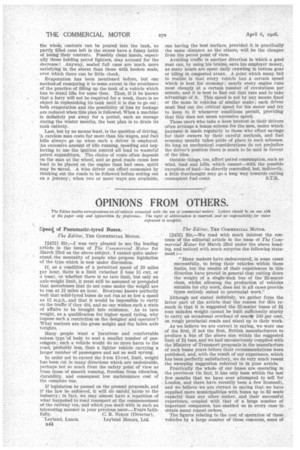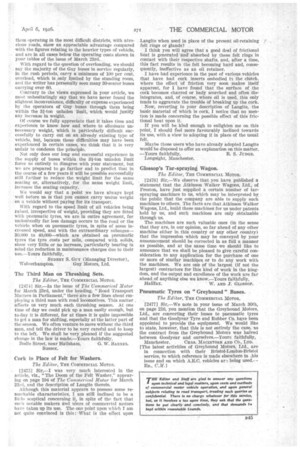OPINIONS FROM OTHERS.
Page 28

Page 29

If you've noticed an error in this article please click here to report it so we can fix it.
2-ke Editor invites corresPondence on alsnbjec1s connected with the Ilse of commercial motors. Letters should be on one side of the paper only and typewritten by preference. The right of abbreviation is reserved, and no responsibility /or views
expressed is accepted,
,Speed of Pneumatic-tyred Buses. • The Editor, THE COMMERCIAL MOTOR.
[2472] Sir,—I was very pleased to see the leading article in the issue of The Commercial Motor for March 23rd on the above subject. I cannot quite understand, the mentality of people who propose legislation of the type which is now under discussion.
If, as a condition of a permitted speed of 20 miles per hour, there is a limit (whether 3 tons 15 cwt. or 4 tons), or whether there is no tare limit, but only an axle-weight limit, it must still be assumed or pretvded that motorbuses that do not come under the weight are to run at 12 miles an hour. Everyone knows perfectly well that solid-tyred buses do not run at so low a speed as 12 m.p.h., and that it would be impossible to carry on the traffic if they did, and no one wishes such a state of affairs to be brought into existence. As to tare weight, as a qualification for higher speed rating, why impose such a restriction on the designer and operator? What matters are the gross weight and the laden axle Weights.
Many, people want a luxurious and comfortable saloon type'of body to seat a smaller number of pas; such a vehicle would do no more harm to the road, probably less, than a lighter vehicle carrying a larger number of passengers and not so well sprung. In order not to exceed the 3-ton 15-cwt. limit, weight has been cut in many directions which are undesirable, perhaps not so much from the safety point of view as from those of smooth running, freedom from vibration, durability, and consequent low maintenance cost of the complete bus.
If legislation be passed on the present proposals, and if the law be enforced, it will do untold. harmto the industry ; in fact, we may almost have a repetition of what happened to road transport at the commencement of the railway era, and which you dealt with in such an interesting manner in your previous issue.—Yours faith
fully, C: B. NIxox (Director), Leyland, Lancs. Leyland Motors, Ltd.
3344
The Editor, THE COMMERCIAL MOTOR.
[2473] Sir,—We read with much interest the contents of the editorial article in the issue of The Commercial Motor for March 23rd under the above heading, and noticed with much surprise the following statement :— " Many makers have endeavoured, in some cases
successfully, to bring their vehicles within these limits, but the results of their experiences in this direction have proved in general that cutting down the weight of a single-deck bus of the 32-seater class, whilst allowing the production of vehicles suitable for city work, does not in all cases provide types entirely suited to provincial work."
Although not stated definitely, we gather from the latter part of the article that the reason for this remark is that it is suggested the 32-seater buses of 3i tons unladen weight cannot be built sufficiently sturdy to carry an occasional overload of neariLy 100 per cent. on rough provincial roads and stand up to their work.
As we believe we are correct in saying, we were one of the first, if not the first, British manufacturers to produce a bus of the above size within the suggested limit of 31 tons, and we had unconsciously complied with the Ministry of Transport proposals in the manufacture of such buses years before their recommendations were published, and, with the result of our experience, which has been perfectly satisfactory, we do very much resent the sweeping suggestion referred to in your article.
Practically the whole of our buses are operating in the provinces (in fact, it has only been within the last few months that we have ever attempted to sell for London, and there have recently been a few licensed), and we believe we are correct in saying that, we have supplied more municipalities with buses up to 32 seats capacity than any other maker, ,,a.nd their successful experience, coupled with that of a large number of important companies, has enabled us in every case to obtain many repeat orders.
The figures relating to the cost of operation of these vehicles by a large number of these concerns, some of them operating 16 the most difficult districts, with atrocious roads, show an appreciable advantage compared -with the figures relating to the heavier types of vehicle, and are in all cases below the operating costs shown in your tables of the issue of March 23rd..
• With regard to the question of overloading, we should pay the majority of the Guy buses In service regularly, in the rushperiods, carry a minimum of 100 per cent.
• overload, which is only limited by the standing room, and the writer has Personally seen many 30-seater buses carrying over 80.
Contrary to the views expressed in Your article, we most unhesitatingly say that we have never found the slightest inconvenience, difficulty or expense experienced by the operators of Guy buses through them being • within the 31-ton unladen limit, which would justify any increase in weight, Of course we fully appreciate that it takes time and experience to know how and whereto eliminate unnecessary weight, which is particularly difficult successfully to carry out on an already existing type of • vehicle, but, because these difficulties may have been experienced in certain eases, we think that it is very unfair to condemn the principle.
Not only does our long and successful experience in the supply of buses 'Within the 3i-ton unladen limit force us entirely to disagree with your statement, but we are prepared to go farther and to predict that in • the course of a few years it will he possible successfully still further to reduce the weight limit for the same • seating or, alternatively, for the same weight limit, increase the seating capacity. We would say that a point we have always kept • well before us is that you cannot carry undue weight a vehicle without paying for its transport.
• With regard to the speed limit of all vehicles being raised, irrespective of weight, providing they are fitted with pneumatic tyres, we are in entire agreement, for undoubtedly far less damage occurs to the road or the , vehicle when on pneumatic tyres, in spite of some in creased speed, and with the extraordinary mileages30,000 to 40,000—which are obtained on pneumatic tyres the tyre costs per mile, compared with solids, show very little or no increase,' particularly bearing in mind the reduction in maintenance charges due to their use.—Yours faithfully, SYDNEY S. GUY' (Managing Director), Wolverhampton. Guy Motors, Ltd.
The Third Man on Threshing Sets.
The Editor, THECOMMERCIAL MOTOR.
[2474] Sir,—In the issue of 'The Commerical Motor for March 23rd, under the heading, "Road Transport Matters in Parliament," there are a few lines about employing a third man with road locomotive's. This matter affects us very much each threshing season. At one time of day we could pick up a man easily enough, but to-day it is different, for at times it is quite impossible . to got a man for shifting, especially at the latter part of the season. We often venture to move without the third man, and tell the driver to be very careful and to keep to the left. We shall be very pleased if the suggested
change In the law is made.—Yours faithfully, • Docile Street, near Hailshatri, G. W. BARNES. Sussex.
Cork in Place of Felt for Washers.
The Editor, THE COMMERCIAL Monet..
[24751 Sir,—I was very much interested in the article, viz., " The Doom of the Pelt Washer," appearing on page 194 of The Commerical Motor for March 23rd, and the description of Langite therein.
Although this material appear § to possess some remarkable characteristics, I, am still inclined to be a little sceptical concerning it, in spite of the fact that stieb notable makers anti ti§ers of commercial motors have taken up its use. The one point upon which I am
• not quite convinced is this : ,What is the •effect upon .
Langite when used in place Of the present oil-retaining felt rings or glands?
I think you will agree that a good deal of frictional heat is generated and` absorbed by these felt rings in contact with their respective shafts, and, after a time, this fact results in the felt becoming hard and, consequently, ineffective as an oil retainer.
I have had experience in the past of various vehicles that have had cork inserts embodied in the clutch, where the effect of friction very soon •makes itself apparent, for I have found that the surface of the cork becomes charred or bady scorched and often disintegrates, and, of course, where oil is used, this only tends to aggravate the trouble of breaking up the cork.
• Now, reverting to your description of Langite, the basic material of which is cork, I notice that no mention is made concerning the possible effect of this frictional heat upon it.
If you will be kind enough to enlighten me on this point, I should feel more favourably inclined towards its use, with a view to adopting it in place of the usual felt.
Maybe those users who have already adopted Langite would be disposed to offer an explanation on this matter.
—Yours faithfully, R. S. .JUDGE. Longsight, Manchester.
Glossop's Tar-spraying Wagon.
The Editor, THE COMMERCIAL MOTOR.
12476] Sir,—We observe that you have published a statement tnat the Atkinson Walker Wagons, Ltd., of Preston, have just supplied a certain number of tar spraying machines to us, which may be interpreted by the public that the company are able to supply such machines to others. The facts are that Atkinson Walker Wagons, Ltd., build these machines for us under patents held by us, and such machines are only obtainable through us.
The machines are such valuable ones (in the sense that they are, in our opinion, so far ahead of any other machine either in this country or any other coutitry) that the impression which may be conveyed by your announcement should be corrected in as full a manner as possible, and at the same time we should like to announce that we shall be pleased to give careful consideration to any application for the purchase of one or more of similar machines or to do any work with the machines. We are one of the largest (if not the largest) contractors for this kind of work in the kingdom, and the output and excellence of the work are far allead_of anything else we know.—Yours faithfully,
Halifax. W. AND J. GLOSSOP.
Pneumatic Tyres on " Greyhound " Buses.
• The Editor, THE COMM4RCIAL MOTOR.
[2477] Sir,---We note in your issue of March 30th, on page 218, you mention that the Greyhound Motors, Ltd., are converting their buses to pneumatic tyres and that the Goodyear Tyre and Rubber Co. have been appointed to provide the equipment. We would like to state, however, that this is not entirely the case, as the contract from the Greyhound Motors was halved between Goodyear and ourselves.—Youre faithfully, Manchester. • CuAs. MACINTOSH AND CO., LTD. [The latest activities of Greyhound Motors, Ltd., are
• in connection with their Bristol-London-Bristol service, to which reference is made elsewhere in his issue and on which A.E.C. vehicles ara being used.-ED., C.M.l
































